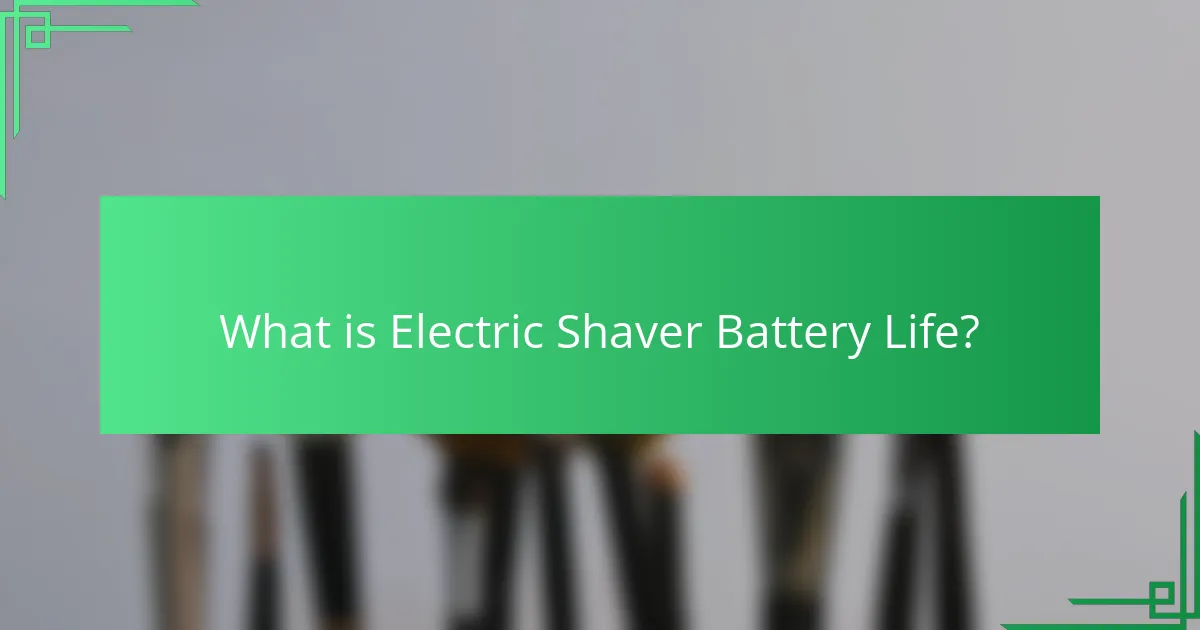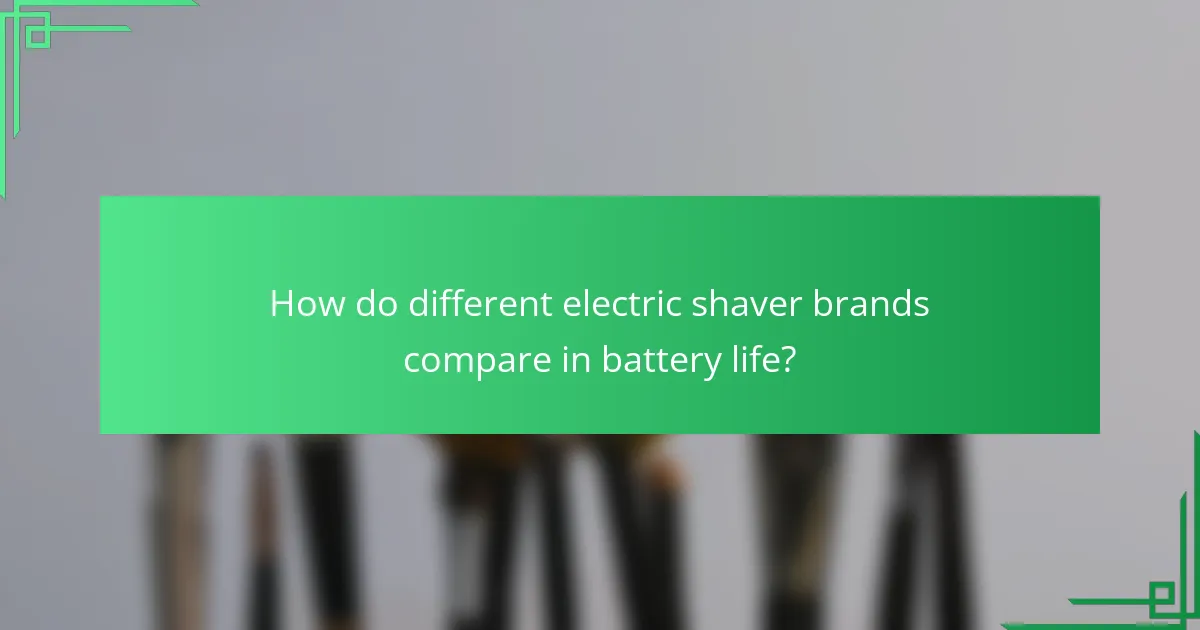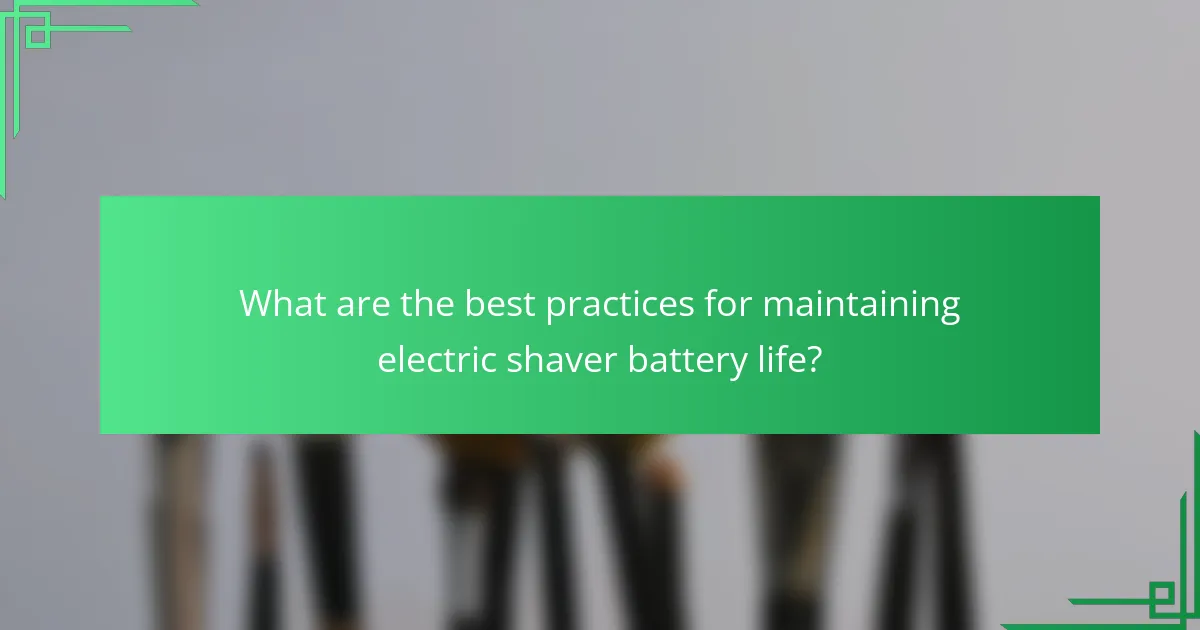Electric shaver battery life is the duration that an electric shaver can operate on a single charge, typically ranging from 30 to 90 minutes of continuous use. This article compares the battery performance and durability of various electric shaver brands, highlighting differences in battery life based on technology, such as lithium-ion versus older nickel-cadmium batteries. High-end models often feature quick charge capabilities, while budget options may have shorter usage times. Additionally, the article provides maintenance tips to extend battery longevity, including proper charging practices and cleaning routines. Understanding these factors is essential for consumers seeking reliable electric shaver performance.

What is Electric Shaver Battery Life?
Electric shaver battery life refers to the duration a shaver can operate on a single charge. Most electric shavers have a battery life ranging from 30 minutes to 90 minutes of continuous use. High-end models may offer quick charge features, providing several minutes of use after just a few minutes of charging. Battery life can vary based on usage frequency and the type of battery technology used. Lithium-ion batteries, commonly found in modern shavers, typically provide longer battery life and quicker charging times compared to older nickel-cadmium batteries. Regular maintenance, such as cleaning and proper charging, can also impact battery longevity.
How does battery life impact the performance of electric shavers?
Battery life directly affects the performance of electric shavers. A fully charged battery ensures optimal power delivery to the motor. This results in efficient cutting and smoother operation. Conversely, a depleted battery can lead to reduced motor speed. Reduced speed may cause uneven shaving and increased tugging on hair. Studies indicate that shavers with longer battery life maintain consistent performance over time. For example, electric shavers with lithium-ion batteries often last longer and perform better than those with nickel-cadmium batteries. Therefore, battery life is crucial for maintaining effective shaving performance.
What factors contribute to the battery life of electric shavers?
The battery life of electric shavers is influenced by several key factors. Battery capacity is crucial; higher mAh ratings typically allow for longer usage times. The type of battery technology, such as lithium-ion, also affects longevity and charging cycles. Power consumption of the shaver’s motor plays a significant role; more efficient motors extend battery life. Additionally, the frequency of use impacts battery wear; regular usage can lead to faster degradation. Charging habits, including overcharging or frequent partial charges, can shorten battery lifespan. Lastly, environmental conditions, like temperature and humidity, can affect battery performance and longevity.
How does battery technology affect electric shaver longevity?
Battery technology directly influences the longevity of electric shavers. Lithium-ion batteries, commonly used in modern shavers, provide longer life cycles compared to older nickel-cadmium batteries. Lithium-ion batteries typically last around 2-3 years with proper care, while nickel-cadmium batteries may only last 1-2 years.
Additionally, lithium-ion batteries charge faster and maintain their charge longer when not in use. This results in more consistent performance over time. In contrast, older battery technologies often suffer from memory effect, leading to reduced capacity and shorter usage times.
Research indicates that shavers with advanced battery technology can offer up to 50% more shaving time per charge. This improvement in battery performance contributes to overall user satisfaction and device longevity.
Why is battery durability important for electric shavers?
Battery durability is important for electric shavers because it directly affects the device’s usability and performance. A durable battery ensures that the shaver can operate for extended periods without needing frequent recharging. This is crucial for users who require efficient grooming, especially when traveling or during busy mornings.
Furthermore, long-lasting batteries contribute to the overall lifespan of the shaver. They reduce wear on internal components caused by repeated charging cycles. Research indicates that lithium-ion batteries, commonly used in electric shavers, can maintain performance for up to 500 charge cycles. This longevity translates to better value for consumers.
In summary, battery durability enhances convenience, performance, and the overall lifespan of electric shavers.
What are the signs of battery wear in electric shavers?
Signs of battery wear in electric shavers include reduced runtime, slow charging, and inconsistent power delivery. A noticeable decrease in how long the shaver operates between charges indicates battery wear. If the shaver takes significantly longer to charge, this may also signal a failing battery. Additionally, if the shaver struggles to maintain power during use, it suggests battery degradation. These symptoms typically arise as lithium-ion batteries age, often after 2-3 years of regular use. Regular monitoring of these signs can help users determine when to replace the battery or the entire shaver for optimal performance.
How can users extend the battery life of their electric shavers?
To extend the battery life of electric shavers, users should follow specific practices. Regularly clean the shaver to prevent hair and debris buildup. Keeping the blades sharp reduces strain on the motor, conserving battery power. Avoid overcharging the battery, as it can degrade battery health over time. Store the shaver in a cool, dry place to prevent overheating. Use the shaver on a lower power setting when possible to save energy. Finally, replace the battery when it shows signs of reduced capacity. These practices can significantly enhance the longevity of the battery in electric shavers.

How do different electric shaver brands compare in battery life?
Different electric shaver brands exhibit varying battery life performance. For instance, brands like Braun and Philips often provide shavers with battery life ranging from 40 to 60 minutes per charge. Panasonic models typically offer similar or slightly longer durations, averaging around 50 to 70 minutes. In contrast, some budget brands may only last 20 to 30 minutes on a single charge. High-end models from premium brands may feature advanced lithium-ion batteries that can last up to 90 minutes. Additionally, some brands include quick charge features that allow for a full shave after just a few minutes of charging. These differences are crucial for consumers seeking reliable performance and durability in electric shavers.
What are the top brands known for superior battery performance?
Panasonic, Braun, Philips, and Remington are the top brands known for superior battery performance in electric shavers. Panasonic offers advanced lithium-ion batteries that provide long-lasting power. Braun’s shavers feature smart battery technology for optimal performance. Philips is recognized for its efficient battery life and quick charging capabilities. Remington also delivers reliable battery performance, ensuring durability and longevity in their products. These brands consistently receive high ratings for battery efficiency and user satisfaction.
How do brand-specific technologies influence battery life?
Brand-specific technologies significantly influence battery life through optimized energy management systems. These systems enhance efficiency by regulating power consumption during operation. For instance, brands like Philips utilize advanced lithium-ion technology, which offers longer-lasting performance compared to standard batteries. Additionally, proprietary charging methods, such as fast charging and smart charging features, reduce downtime and extend overall battery longevity. Research shows that electric shavers with integrated power-saving modes can increase battery life by up to 30%. This demonstrates how tailored technologies directly impact the duration and reliability of battery performance in electric shavers.
What user reviews highlight battery performance differences among brands?
User reviews indicate significant battery performance differences among electric shaver brands. For instance, many users report that Brand A’s shavers consistently last up to 60 minutes on a full charge. In contrast, Brand B’s models often provide only 30 to 40 minutes of usage. Users also highlight that Brand C offers quick charging capabilities, achieving a full charge in just one hour. Additionally, Brand D’s shavers are noted for maintaining battery life over time, with minimal degradation after multiple charges. Reviews emphasize that Brand E’s battery performance is less reliable, frequently requiring more frequent recharging. Overall, these insights reflect distinct variances in battery longevity and efficiency across different electric shaver brands.
What types of batteries are commonly used in electric shavers?
Electric shavers commonly use lithium-ion and nickel-metal hydride batteries. Lithium-ion batteries are favored for their high energy density and longevity. They typically provide longer usage times and faster charging capabilities. Nickel-metal hydride batteries are also used, though they tend to have a shorter lifespan. These batteries are often less expensive but may require more frequent replacements. The choice between these battery types affects the overall performance and durability of electric shavers.
What are the advantages of lithium-ion batteries in electric shavers?
Lithium-ion batteries offer several advantages in electric shavers. They provide a higher energy density compared to other battery types. This results in longer usage times per charge. Lithium-ion batteries also have a lower self-discharge rate. This means they retain charge longer when not in use. Additionally, they are lighter and more compact. This contributes to a more ergonomic design of electric shavers. Lithium-ion batteries support fast charging capabilities. Many models can be fully charged in under an hour. Finally, they have a longer lifespan with up to 500 charge cycles. This durability makes them a cost-effective choice for consumers.
How do NiMH batteries compare to lithium-ion in terms of durability?
NiMH batteries generally have lower durability compared to lithium-ion batteries. NiMH batteries typically endure around 500 charge cycles before significant capacity loss. In contrast, lithium-ion batteries can sustain approximately 1000 to 2000 charge cycles. The self-discharge rate of NiMH batteries is higher, leading to faster capacity loss when not in use. Lithium-ion batteries maintain their charge longer during storage. Additionally, lithium-ion batteries are less prone to memory effect issues, which can degrade performance over time. Overall, lithium-ion batteries offer superior longevity and reliability for electric shavers.

What are the best practices for maintaining electric shaver battery life?
To maintain electric shaver battery life, regularly charge the device fully before first use. Avoid letting the battery completely discharge frequently. This practice helps preserve battery health. Store the shaver in a cool, dry place to prevent overheating. Clean the shaver after each use to ensure optimal performance. Use the manufacturer’s recommended charger to avoid damage. Additionally, replace the battery as needed, following manufacturer guidelines. These practices can extend the lifespan of the battery significantly.
How should users charge their electric shavers for optimal battery performance?
Users should charge their electric shavers according to the manufacturer’s guidelines for optimal battery performance. Most electric shavers benefit from being charged fully before the first use. It is advisable to avoid overcharging the device, as this can reduce battery lifespan. Users should also charge the shaver after each use to maintain battery health. Keeping the shaver in a cool, dry place while charging is essential. Frequent deep discharges can negatively impact battery longevity. Lithium-ion batteries, commonly used in electric shavers, perform best when kept between 20% and 80% charge. Following these practices can help ensure the longevity and efficiency of the electric shaver’s battery.
What charging habits can negatively impact battery longevity?
Frequent overcharging can negatively impact battery longevity. Overcharging leads to heat buildup, which accelerates battery degradation. Keeping the shaver plugged in after reaching 100% charge can cause this issue. Additionally, allowing the battery to fully discharge regularly can also harm its lifespan. Lithium-ion batteries, common in electric shavers, prefer partial discharge cycles. Charging the battery in high-temperature environments further shortens its life. Using non-compatible chargers can also damage the battery. These practices contribute to reduced overall battery performance and durability.
How often should electric shaver batteries be replaced?
Electric shaver batteries should typically be replaced every 1 to 3 years. The lifespan depends on usage frequency and battery type. Lithium-ion batteries generally last longer than nickel-metal hydride batteries. Signs that a battery needs replacement include reduced runtime and longer charging times. Regular maintenance can also affect battery longevity. For optimal performance, follow the manufacturer’s guidelines for battery care.
What troubleshooting tips can help with battery-related issues in electric shavers?
To resolve battery-related issues in electric shavers, first check the charging cable and adapter for damage. Ensure they are functioning properly by testing with another compatible device. Next, inspect the battery contacts for corrosion or dirt. Clean them gently with a soft cloth if needed. If the shaver does not hold a charge, consider replacing the battery, as lithium-ion batteries typically have a lifespan of 2-3 years. Additionally, ensure the shaver is not used while charging, as this can affect battery performance. Regularly update the firmware if applicable, as software issues can impact battery efficiency. Follow these steps to maintain optimal battery health and performance.
How can users identify battery problems in their electric shavers?
Users can identify battery problems in their electric shavers by observing performance issues. Common signs include reduced runtime during use. Users may also notice longer charging times than usual. If the shaver fails to hold a charge, it indicates a battery issue. Unusual heat during charging can signal battery malfunction. A blinking indicator light may also suggest battery problems. Finally, physical damage to the battery or shaver can indicate issues. Regular maintenance can help prevent these problems from worsening.
What steps can be taken to resolve common battery issues?
To resolve common battery issues, first, check the battery connections for corrosion or loose wires. Clean any corrosion with a mixture of baking soda and water. Ensure the battery is charged properly. Use the manufacturer’s recommended charger for optimal performance. If the battery is old, consider replacing it with a new one. Test the battery with a multimeter to check voltage levels. If the battery does not hold a charge, it may be defective and require replacement. Following these steps can extend the battery life and improve performance.
Electric shaver battery life is a critical aspect that influences performance and user satisfaction, typically ranging from 30 to 90 minutes on a single charge. This article examines the factors affecting battery life, including battery technology, capacity, and maintenance practices, with a focus on the advantages of lithium-ion batteries over nickel-cadmium options. It also compares battery performance across leading brands like Panasonic, Braun, and Philips, highlighting user reviews and best practices for extending battery longevity. Additionally, the article addresses common battery issues and troubleshooting tips to enhance the overall durability and efficiency of electric shavers.